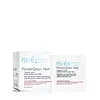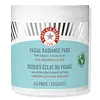What's inside
What's inside
 Key Ingredients
Key Ingredients

 Benefits
Benefits

 Concerns
Concerns

 Ingredients Side-by-side
Ingredients Side-by-side

Water
Skin ConditioningSd Alcohol 40-B
AstringentGlycolic Acid
BufferingPentylene Glycol
Skin ConditioningHamamelis Virginiana Water
AstringentSalicylic Acid
MaskingPhytonadione Epoxide
AstringentVaccinium Myrtillus Fruit Extract
Skin ConditioningChamomilla Recutita Flower Extract
MaskingCamellia Sinensis Leaf Extract
AntimicrobialLactic Acid
BufferingCitric Acid
BufferingBoerhavia Diffusa Root Extract
Skin ProtectingCitrus Limon Fruit Extract
MaskingCitrus Aurantium Dulcis Fruit Extract
MaskingSaccharum Officinarum Extract
MoisturisingMentha Piperita Oil
MaskingLavandula Angustifolia Oil
MaskingAcer Saccharum Extract
Skin ConditioningGlycerin
HumectantSuperoxide Dismutase
AntioxidantAmmonium Hydroxide
BufferingPolysorbate 20
EmulsifyingButylene Glycol
HumectantAlcohol
AntimicrobialDisodium EDTA
Zinc PCA
HumectantWater, Sd Alcohol 40-B, Glycolic Acid, Pentylene Glycol, Hamamelis Virginiana Water, Salicylic Acid, Phytonadione Epoxide, Vaccinium Myrtillus Fruit Extract, Chamomilla Recutita Flower Extract, Camellia Sinensis Leaf Extract, Lactic Acid, Citric Acid, Boerhavia Diffusa Root Extract, Citrus Limon Fruit Extract, Citrus Aurantium Dulcis Fruit Extract, Saccharum Officinarum Extract, Mentha Piperita Oil, Lavandula Angustifolia Oil, Acer Saccharum Extract, Glycerin, Superoxide Dismutase, Ammonium Hydroxide, Polysorbate 20, Butylene Glycol, Alcohol, Disodium EDTA, Zinc PCA
Water
Skin ConditioningAloe Barbadensis Leaf Juice
Skin ConditioningGlycerin
HumectantCucumis Sativus Fruit Extract
EmollientLactic Acid
BufferingGlycolic Acid
BufferingLeuconostoc/Radish Root Ferment Filtrate
AntimicrobialChrysanthemum Parthenium Extract
Skin ConditioningSodium Hydroxide
BufferingPolysorbate 20
EmulsifyingCamellia Sinensis Leaf Extract
AntimicrobialGlycyrrhiza Glabra Root Extract
BleachingCitrus Nobilis Fruit Extract
MaskingCitrus Limon Peel Extract
EmollientHyaluronic Acid
HumectantPhyllanthus Emblica Fruit Extract
HumectantEDTA
Tetrasodium EDTA
Phenoxyethanol
PreservativeChlorphenesin
AntimicrobialWater, Aloe Barbadensis Leaf Juice, Glycerin, Cucumis Sativus Fruit Extract, Lactic Acid, Glycolic Acid, Leuconostoc/Radish Root Ferment Filtrate, Chrysanthemum Parthenium Extract, Sodium Hydroxide, Polysorbate 20, Camellia Sinensis Leaf Extract, Glycyrrhiza Glabra Root Extract, Citrus Nobilis Fruit Extract, Citrus Limon Peel Extract, Hyaluronic Acid, Phyllanthus Emblica Fruit Extract, EDTA, Tetrasodium EDTA, Phenoxyethanol, Chlorphenesin
 Reviews
Reviews

Ingredients Explained
These ingredients are found in both products.
Ingredients higher up in an ingredient list are typically present in a larger amount.
Camellia Sinensis Leaf Extract is derived from the leaves of the tea plant. Black tea, green tea, and oolong tea are all harvested from this plant.
This ingredient has many skin benefits:
This ingredient contains polyphenols, a strong antioxidant. Antioxidants help fight off molecules that damage skin cells.
On top of that, the antioxidants in green tea neutralize free-radicals from the sun. This gives the skin some extra UV protection, but should not replace sunscreen.
Many components of tea have anti-inflammatory properties.
Polyphenols and L-theanine help soothe the skin and reduce irritation. The caffeine in Camellia Sinensis Leaf Extract helps calm inflamed blood vessels.
Other compounds found in tea include: Vitamin Bs, linoleic acid, magnesium, calcium, iron, and zinc.
Research has shown both drinking Camellia Sinensis Leaf Tea and applying it to the skin can help boost skin elasticity and hydration. Studies also show using tea extract may reduce sebum, or oil, production.
Learn more about Camellia Sinensis Leaf ExtractGlycerin is already naturally found in your skin. It helps moisturize and protect your skin.
A study from 2016 found glycerin to be more effective as a humectant than AHAs and hyaluronic acid.
As a humectant, it helps the skin stay hydrated by pulling moisture to your skin. The low molecular weight of glycerin allows it to pull moisture into the deeper layers of your skin.
Hydrated skin improves your skin barrier; Your skin barrier helps protect against irritants and bacteria.
Glycerin has also been found to have antimicrobial and antiviral properties. Due to these properties, glycerin is often used in wound and burn treatments.
In cosmetics, glycerin is usually derived from plants such as soybean or palm. However, it can also be sourced from animals, such as tallow or animal fat.
This ingredient is organic, colorless, odorless, and non-toxic.
Glycerin is the name for this ingredient in American English. British English uses Glycerol/Glycerine.
Learn more about GlycerinGlycolic Acid is arguably the most famous alpha hydroxy acid (AHA) with tons of research backing its benefits.
It is found naturally in sugar cane but the form used in skincare is usually synthetic for purity and stability.
Glycolic acid removes the top layer of dead skin cells to allow newer and fresher ones to emerge.
AHAs work by breaking down the structural “glue” that holds old skin cells in place. When that buildup is gone, your skin can renew itself more efficiently.
Research also shows glycolic acid stimulates collagen production, helping to firm and thicken the skin over time. This is one of its biggest advantages over other AHAs.
Overall, glycolic acid helps with:
Fun fact: Glycolic acid boosts skin hydration by helping it produce molecules that increase hyaluronic acid naturally.
To work best, glycolic acid products should have a pH between 3-4 (that’s where exfoliation is most effective but still gentle on skin).
The pH and concentration of a product are key to its effectiveness:
It is normal to feel a slight stinging sensation when using glycolic acid. This usually fades as your skin adjusts.
Because glycolic acid has the smallest molecular size in the AHA family, it can penetrate deeper, which enhances its effectiveness but also makes it more likely to irritate sensitive skin.
If your skin is very sensitive or prone to rosacea, glycolic acid may be too strong; in that case, try milder options like lactic acid or a PHA instead.
Recent studies suggest glycolic acid might even help protect against UV damage. But don’t skip sunscreen! Freshly exfoliated skin is more sensitive to the sun.
Glycolic acid is a skincare superstar. It smooths, brightens, hydrates, and firms the skin. Unless you’re highly sensitive, it’s well worth adding to your routine.
Read more about some other popular AHA's here:
Learn more about Glycolic AcidLactic Acid is another well-loved alpha hydroxy acid (AHA). It is gentler than glycolic acid but still highly effective.
Its main role is to exfoliate the surface of the skin by loosening the “glue” that holds dead skin cells together. Shedding those old cells leads to smoother, softer, and more even-toned skin.
Because lactic acid molecules are larger than glycolic acid, they don’t penetrate as deeply. This means they’re less likely to sting or irritate, making it a great choice for beginners or those with sensitive skin.
Like glycolic acid, it can:
Lactic acid also acts as a humectant (like hyaluronic acid). It can draw water into the skin to improve hydration and also plays a role in the skin's natural moisturizing factor (NMF) in the form of sodium lactate.
Studies show it can boost ceramide production to strengthen the skin barrier and even help balance the skin’s microbiome.
To get results, choose products with a pH between 3-4.
Lower strengths (5-12%) focus on surface exfoliation; higher strengths (12% and up) can reach deeper in the dermis (deeper, supportive layer) to improve skin texture and firmness over time.
Though it was originally derived from milk, most modern lactic acid used in skincare is vegan. It is made through non-dairy fermentation to create a bio-identical and stable form suitable for all formulations.
When lactic acid shows up near the end of an ingredient list, it usually means the brand added just a tiny amount to adjust the product’s pH.
Legend has it that Cleopatra used to bathe in sour milk to help reduce wrinkles.
Lactic acid is truly a gentle multitasker: it exfoliates, hydrates, strengthens, and brightens. It's a great ingredient for giving your skin a smooth, glowing, and healthy look without the harshness of stronger acids.
Read more about some other popular AHA's here:
Learn more about Lactic AcidPolysorbate 20 is made by combining ethoxylation of sorbitan, ethylene oxide, and lauric acid. It is a mild cleansing agent, surfactant, and emulsifier.
As a surfactant, it helps collect dirt and oils for washing. Emulsifiers prevent oils and water from separating.
Polysorbate 20 also adds scent to a product. Since it is made using sorbitol, it has a sweet scent. Sorbitol can also be found in fruits such as apples and peaches.
The lauric acid used to create Polysorbate 20 is often derived from coconuts.
Polysorbate 20 may not be fungal acne safe.
Learn more about Polysorbate 20Water. It's the most common cosmetic ingredient of all. You'll usually see it at the top of ingredient lists, meaning that it makes up the largest part of the product.
So why is it so popular? Water most often acts as a solvent - this means that it helps dissolve other ingredients into the formulation.
You'll also recognize water as that liquid we all need to stay alive. If you see this, drink a glass of water. Stay hydrated!
Learn more about Water